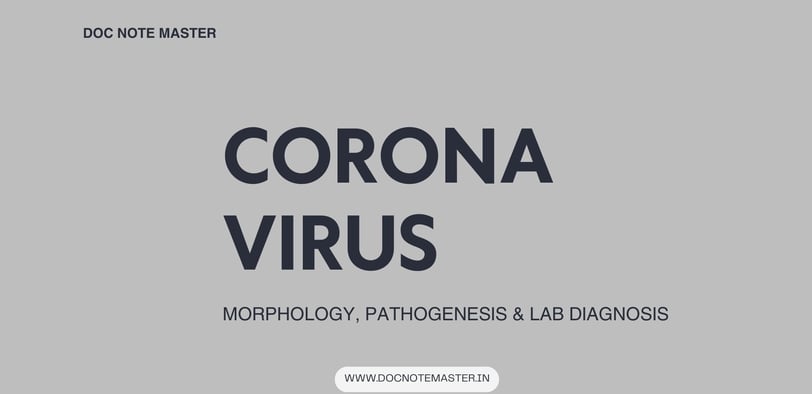online learning with Doc note master|| Himanshu paneru
CORONA VIRUS
Corona virus are the second most important cause of common cold. The corona virus have also been reported to cause gastro-entritis in children and adult.
SYSTEMIC BACTERIOLOGY


Corona virus
·Corona virus are the second most important cause of common cold.
· The corona virus have also been reported to cause gastro-entritis in children and adult.
Morphology
· Size – 60 to 120 nm
· shape – spherical in shape
· enveloped – present
· genetic material- single stranded positive sense RNA virus
· motility- non-motile
Pathogenesis
· corona virus cause infection in upper respiratory tract
· Human corona virus is respiratory for 30% cases of common cold
# Source of infection: Infected droplet such as cough, sneeze, etc.
# Mode of infection: close contact with infected person
# Route of infection: fecal oral route
# Incubation period: incubation period varies from 2-5 days.
· Corona virus cause following condition.
1. Common cold:
Corona virus cause more commonly upper respiratory tract or less commonly lower respiratory tract illness in human.
Common cold caused by corona virus has an incubation period of 3 days.
2. Gastroenteritis:
The corona virus have been reported to cause gastroenteritis in children and adult.
The symptoms are mild and the condition is self limiting.
3. SARS:
SARS is a potentially life threating infection associated with the onset of flu like syndrome.
The incubation period varies from 2 to 7 days althrough it may be as long as 2 week.
SARS characterized by:
Fever
Fatigue
Chills
Malaise
Anorexia
Myalgia
SARS condition is associated with lymphadenopathy and thrombocytopenia.
The mortality rate of SARS is higher than influenza and other respiratory illness.
# Symptoms
Symptoms in corona virus include
Fever
Cough (usually dry)
Shortness of breath
Fatigue
Headache
Loss of taste
Sore throat
Nausea or vomiting
Diarrhea
Cheat pain
Skin rashes
Laboratory diagnosis
Laboratory diagnosis of corona virus is done on the bases type of specimen, collection and transport, isolation of virus, antigen detection, antibody detection, etc.
# Specimen:
Nasopharyngeal swab
Throat swab
Saliva
Stool
Tracheal aspirate
Serum
Sputum
# Collection:
Specimen is collected with sterile swab or in leak proof sterile container.
# Transport:
Most swab specimen are placed in viral transport medium (VTM) or sterile saline.
Temperate 2 to 8 °C.
# Isolation:
Human corona virus can be isolated in human foetal tracheal organ culture.
Some strain grow on monolayer of diploid human embrayonic fibroblast with minimal cytopathic effect.
Other specimen can be isolated on vero cell lines
# RT-PCR:
High sensitivity and specificity can detect infection in early stages.
# Antigen detection:
These test detect viral protein rather than DNA.
# Antibody detection:
Enzyme linked immunosorbent assay (ELISA) are used to detect antibody.
Treatment
No specific antiviral treatment is available against SARS.
Prevention and control
Vaccination: most effective way to prevent corona virus infection
Physical distance
Hygiene
Cover mouth and nose with mask
About author
Himanshu Paneru is the founder and author of DOC NOTE MASTER,
a platform dedicated to sharing insightful articles on medical topics
and education. Currently pursuing a master’s degree in Medical
microbiology at Netaji subhash chandra bose sybharti medical
college Dehradun, Uttarakhand. Himanshu combines his academic
knowledge with a passion for writing.


